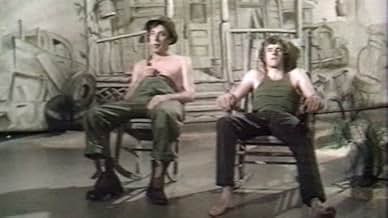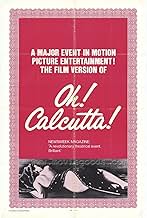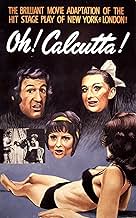Ajouter une intrigue dans votre langueBased on the controversial off-Broadway musical comedy revue, "Oh! Calcutta! is a series of musical numbers about sex and sexual mores. Most of the skits feature one or more performers in ei... Tout lireBased on the controversial off-Broadway musical comedy revue, "Oh! Calcutta! is a series of musical numbers about sex and sexual mores. Most of the skits feature one or more performers in either a state of undress, simulating sex, or both.Based on the controversial off-Broadway musical comedy revue, "Oh! Calcutta! is a series of musical numbers about sex and sexual mores. Most of the skits feature one or more performers in either a state of undress, simulating sex, or both.
- Réalisation
- Scénario
- Casting principal
Avis à la une
This move is a mostly funny mostly naked satire of sexuality of the times, circa 1970, that still holds up today.The bodies are perfect and most of the gags are right on the money.It was written by some of the best writers of this century and the acting is superb.The dance numbers are some of the most innovative ever choreographed and the people are naked--isn't that what your always wanted to see in a modern dance routine anyway!Be sure to check out the "Sex Clinic" sketch, it will leave you in stitches!
First the film, then the stage production: Okay - this was filmed long before anyone had a home video system - it was back when videotape was a fairly new phenomenon, the player/recorders were far too expensive to be considered for home use, and electronic manipulation of the images was sparkly and new. There are some annoying transition special effects, some cute double-exposure shots, a scene that takes place in a forest glade instead of on-stage, and a scene that's not shown at all - you see a long cut of the outside of a building while you hear what's happening on stage - presumably because of simulated intercourse, though that's apparently not an issue later in the play.
Side note to cinematographers who film plays - just show the audience what they'd see if they were watching the stage production. That's what they expect - it won't disappoint them. A split screen is okay if it's not overdone - but don't cut to the audience during anything but closed-curtain time, don't show closeups of a couple of actors when the whole ensemble is on-stage and moving, and please, please, don't show a line of Celtic dancers from the waist up, ignoring the footwork.
There - had to get that off my chest. Sorry.
Most of the camera-work here is actually pretty good - the annoying parts happened in editing, and the incomprehensible decision to take the one scene away from the stage and put it elsewhere - I'd rather have seen what the actual audience saw.
The stage production - a series of dance numbers and skits about sex - the pain of it, the joy of it, the general absurdity of how it's dealt with in our society. There's some pathos, lots of comedy, some dirty gleeful joy, and some of it falls flat - but some will hit you where you live. By 2005 standards, it's really pretty tame - by 1972 standards in the USA, it was outrageous and shocking. Much of the reason that it's pretty tame now is that it dared to be shocking in 1972 - those who enjoy sexual freedom today owe the folks who dared to do this then. Some of the songs were interesting, but the music was largely forgettable - not everyone has a hit every time out.
As social history, it's interesting. As entertainment, it's spotty, but very fun in parts - well worth an evening. It was really much more fun than I'd expected.
Side note to cinematographers who film plays - just show the audience what they'd see if they were watching the stage production. That's what they expect - it won't disappoint them. A split screen is okay if it's not overdone - but don't cut to the audience during anything but closed-curtain time, don't show closeups of a couple of actors when the whole ensemble is on-stage and moving, and please, please, don't show a line of Celtic dancers from the waist up, ignoring the footwork.
There - had to get that off my chest. Sorry.
Most of the camera-work here is actually pretty good - the annoying parts happened in editing, and the incomprehensible decision to take the one scene away from the stage and put it elsewhere - I'd rather have seen what the actual audience saw.
The stage production - a series of dance numbers and skits about sex - the pain of it, the joy of it, the general absurdity of how it's dealt with in our society. There's some pathos, lots of comedy, some dirty gleeful joy, and some of it falls flat - but some will hit you where you live. By 2005 standards, it's really pretty tame - by 1972 standards in the USA, it was outrageous and shocking. Much of the reason that it's pretty tame now is that it dared to be shocking in 1972 - those who enjoy sexual freedom today owe the folks who dared to do this then. Some of the songs were interesting, but the music was largely forgettable - not everyone has a hit every time out.
As social history, it's interesting. As entertainment, it's spotty, but very fun in parts - well worth an evening. It was really much more fun than I'd expected.
After the musical Hair combined a little nudity with a lot of witty, tuneful songs, Oh Calcutta came along and combined a lot of nudity with a number of remarkably dull sketches.
For the most part, these sketches appear to have a humorous intent, yet none of them come close to be really funny, although one short sketch about masturbating is mildly amusing. And at the end the actors put words in the mouths of the audience, and some of those lines are actually pretty good.
My first inclination was to stop watching altogether, but when I looked up the play in Wikipedia I saw that the sketches had been written by a number of famous people, including Jules Pfeiffer and Sam Shepard. So what I did was, I would watch the first few minutes of a sketch, fast forward when I got bored, check out a little of the sketch later on to see if it got better, which it never did, and go to the next sketch.
There are also a couple of naked dance numbers, which, like everything else, aren't especially good. And there are a few songs, co-written by the guy who created P.D.Q. Bach, that are really cheesy and bland.
In terms of the filming of the play, the beginning is awful. You see the audience (clearly not a real audience but actors chosen to look like an uptight crowd) and then backstage footage of the actors. Then there's some annoying video effects when the play starts. After that the director settles down for the most part and just lets the play unfold, but since it's a bad play, that's little comfort.
Why was Oh Calcutta one of the longest running Broadway plays? I've got to assume it's all the naked people. I think at the time it just seemed daring to go watch naked people grope each other on stage and talk about masturbation and wife swapping. It was transgressive and revolutionary. Unfortunately, it was also really bad.
It's so annoying that there's video of the original Oh Calcutta but none, so far as I can tell, of the original Hair. All we have is that horrible movie made in the seventies in which they took the name and a few of the songs and created something new and much worse. How is that fair?
For the most part, these sketches appear to have a humorous intent, yet none of them come close to be really funny, although one short sketch about masturbating is mildly amusing. And at the end the actors put words in the mouths of the audience, and some of those lines are actually pretty good.
My first inclination was to stop watching altogether, but when I looked up the play in Wikipedia I saw that the sketches had been written by a number of famous people, including Jules Pfeiffer and Sam Shepard. So what I did was, I would watch the first few minutes of a sketch, fast forward when I got bored, check out a little of the sketch later on to see if it got better, which it never did, and go to the next sketch.
There are also a couple of naked dance numbers, which, like everything else, aren't especially good. And there are a few songs, co-written by the guy who created P.D.Q. Bach, that are really cheesy and bland.
In terms of the filming of the play, the beginning is awful. You see the audience (clearly not a real audience but actors chosen to look like an uptight crowd) and then backstage footage of the actors. Then there's some annoying video effects when the play starts. After that the director settles down for the most part and just lets the play unfold, but since it's a bad play, that's little comfort.
Why was Oh Calcutta one of the longest running Broadway plays? I've got to assume it's all the naked people. I think at the time it just seemed daring to go watch naked people grope each other on stage and talk about masturbation and wife swapping. It was transgressive and revolutionary. Unfortunately, it was also really bad.
It's so annoying that there's video of the original Oh Calcutta but none, so far as I can tell, of the original Hair. All we have is that horrible movie made in the seventies in which they took the name and a few of the songs and created something new and much worse. How is that fair?
With the Broadway revival of Hair making waves,is the possibility of a revival of Oh! Calcutta! out of the question? This play opened hot on the heels of Hair in 1970 to an eager audience,clamoring for more on- stage nudity (and more they got). Like Hair, Oh! Calcutta! doesn't have so much of a standard plot,but a series of comic blackouts/sketches,dealing with sexual issues of the era. The individual stories were submitted by the likes of John Lennon,Kenneth Tynan,and others. Several sketches contain either partial,or full frontal nudity (both male & female),but not always. The musical score was composed by a ensemble that called itself 'The Open Window',that included Peter Schekele (of P.D.Q.Bach fame). This filmed play was shot on video tape during a live performance,and transferred to film, giving it a different visual texture, than if it had been shot on standard 35mm film stock. The cast of Oh! Calcutta! are made up of relative unknowns (at least for that time),but one cast member is Bill Macy,who would become famous for being a regular in the television series,'Maude' some years later. The show also includes a few song and dance numbers that actually don't seem just slotted in for the sake of padding the show/film out (including one nude ballet sequence that really works). Let the kids spend the night at Grandmother & Grandfather's house,unplug the phone,pour a drink (or two),pop this in your DVD (or VHS video)player & enjoy! Originally given an 'X' rating by the MPAA, this film contains wall to wall nudity,strong pervasive sexual content,and naughty language.
I rented this for the same reason people went to see it when it was filmed: I'd heard about the sex & nudity and I was curious. I got a lot more than that; it's a time capsule.
The video was made from a closed-circuit TV recording at a live theater performance. I can only assume it's a fairly honest reproduction of the real thing. It's a few nude dance numbers along with quite a few skits. The skits are comedic, nearly all involve nudity, and are all about sex in one way or another. Topics range from masturbation to swinging to kinky toys and more. They're at least as amusing as, and only slightly more sophisticated than, your basic Benny Hill Show. On face value alone it was worth the $1 rental (as long as you're not one who takes his theater experience too seriously).
Its real value comes from its representation of the sexual revolution. It's hard to imagine that it had problems with obscenity laws considering what's available from a wide variety of sources today. It was controversial simply because people talked freely about sex and were naked. When the actors were naked, they neither hid nor flaunted it; they simply were, and appeared happy to be so. They cheerfully acted out skits that portrayed sex as neither serious nor dirty but just plain silly and fun. Compared to the modern business of sex, this is a breath of fresh air which made me long for a simpler time that I barely remember (and may not have ever actually existed).
The same day I saw this was the Janet Jackson/SuperBowl brouhaha, later described as "a perfect opportunity to both sell sex and condemn it." Oh! Calcutta! does neither. The closing number has the cast stripping to nude and dancing gleefully to a song whose chorus is "I don't care what you say / I'll do it anyway / Because it's mine!" That's the sexual revolution in a nutshell; for us to deny ourselves the pleasure our bodies bring us is to remove a large part of the joy of living. But today it's just one more thing for sale.
Cast member and choreographer Margo Sappington has gone on to become a somewhat influential figure in the world of dance.
The video was made from a closed-circuit TV recording at a live theater performance. I can only assume it's a fairly honest reproduction of the real thing. It's a few nude dance numbers along with quite a few skits. The skits are comedic, nearly all involve nudity, and are all about sex in one way or another. Topics range from masturbation to swinging to kinky toys and more. They're at least as amusing as, and only slightly more sophisticated than, your basic Benny Hill Show. On face value alone it was worth the $1 rental (as long as you're not one who takes his theater experience too seriously).
Its real value comes from its representation of the sexual revolution. It's hard to imagine that it had problems with obscenity laws considering what's available from a wide variety of sources today. It was controversial simply because people talked freely about sex and were naked. When the actors were naked, they neither hid nor flaunted it; they simply were, and appeared happy to be so. They cheerfully acted out skits that portrayed sex as neither serious nor dirty but just plain silly and fun. Compared to the modern business of sex, this is a breath of fresh air which made me long for a simpler time that I barely remember (and may not have ever actually existed).
The same day I saw this was the Janet Jackson/SuperBowl brouhaha, later described as "a perfect opportunity to both sell sex and condemn it." Oh! Calcutta! does neither. The closing number has the cast stripping to nude and dancing gleefully to a song whose chorus is "I don't care what you say / I'll do it anyway / Because it's mine!" That's the sexual revolution in a nutshell; for us to deny ourselves the pleasure our bodies bring us is to remove a large part of the joy of living. But today it's just one more thing for sale.
Cast member and choreographer Margo Sappington has gone on to become a somewhat influential figure in the world of dance.
Le saviez-vous
- AnecdotesThe title is a pun on the French phrase, "Oh, quel cul t'as!", meaning, "Oh, what a cute bum you have!" It is taken, pun and all, from a painting Clovis Trouille (1889-1975) "Oh! Calcutta! Calcutta!". The title is written on the original painting at the right on the lower edge. The image of the painting appears in the background in the beginning.
- GaffesDuring the finale, the camera crew is reflected in the mirrors. As the camera pans around, a crew member tries to run out of the shot.
- Versions alternativesVideo and DVD version runs 123 minutes with an extra scene shot in a park setting.
- ConnexionsReferenced in Avanti! (1972)
Meilleurs choix
Connectez-vous pour évaluer et suivre la liste de favoris afin de recevoir des recommandations personnalisées
- How long is Oh! Calcutta!?Alimenté par Alexa
Détails
Box-office
- Montant brut aux États-Unis et au Canada
- 405 750 $US
Contribuer à cette page
Suggérer une modification ou ajouter du contenu manquant














